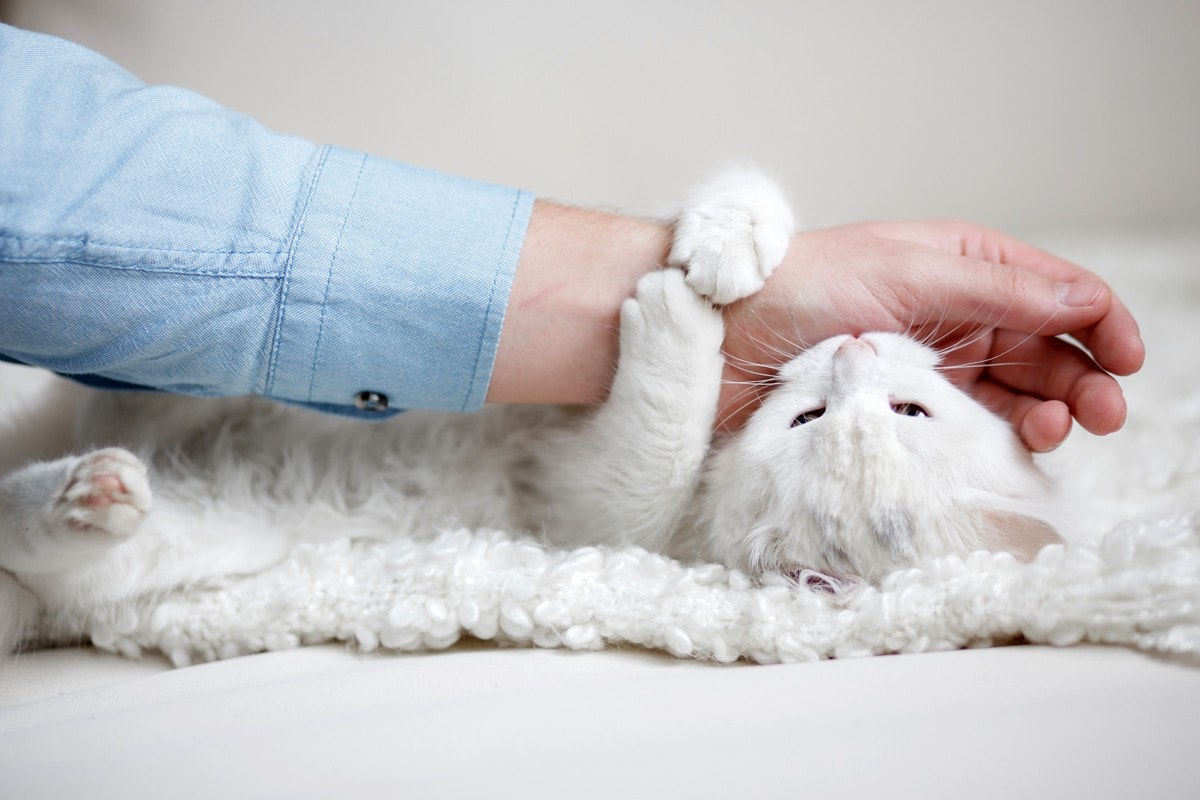Why do cats bite?
There are several possible causes of biting in cats; it depends entirely on the situation at the time. Biting is primarily the result of fear and or aggression. Some cats, especially young ones may also bite as a form of play.
I cannot emphasise enough that this behaviour should not be encouraged. It might be cute when a little kitten nipping you, but when it’s a full-grown cat.
Injured or scared:
No matter how friendly your cat is, if he is injured or afraid, he is at risk of biting you. He may not even be aware he is doing it which is why an injured, or scared cat should ALWAYS be approached with a great deal of caution.
Breaking up a cat fight:
A very common cause of pet owners being bitten is getting between two cats fighting. This is an absolute no-no. If you need to break up a fight, throw a towel over them, get a broom and gently try to prise them apart, do not use your hands, arms or legs to split them up. That is a recipe for disaster and a trip to the emergency department is a likely outcome.
Once you have broken apart from a cat fight, your cat(s) are likely to be agitated for quite some time afterwards. It is a good idea to maintain some distance between you and your cat(s) until they have had sufficient time to calm down.
During a seizure:
Many pet owners think cats having a seizure are at risk of swallowing their tongue. Well-meaning pet owners have been accidentally bitten by sticking a finger in the mouth to stop this from happening. A cat will not bite its tongue during a seizure and for your own sake, keep fingers away from a cat having a seizure.
Playing:
Cats learn social behaviour from their mother and siblings, if a young kitten bites a littermate too hard, he or she will be quickly put in their place. Without this early experience, cats can miss all-important social cues. Pet owners can also encourage biting during kittenhood when they roughhouse with the cat, which teaches them that hands are a target. This may not hurt when the kitten is young, but it can lead to serious injury when the cat is larger and stronger.
Related: Why Does My Cat Bite My Nose?
Petting induced
This form of aggression occurs when a pet owner is interacting with a cat and the cat suddenly lashes out at the owner then darts away. The exact cause of petting induced aggression is still not fully understood but it is thought that the cat becomes over-stimulated at which point it becomes too much for the cat. Most cats will display subtle clues when they are reaching that threshold which includes tail swishing and looking into the distance. At this point, back away and allow the cat to have a cooling-off period. Cats may even purr before biting.
Learn more about petting-induced biting with Janet Cutler, a Certified Cat Behaviorist, in our related articles:
- My Cat Purrs And Bites Me Gently
- My Cat Bites When I Pet Her
- Why Does My Cat Lick Me Then Bite Me?
- Why Does My Cat Bite My Nose? A Cat Expert Explains
How to stop a cat biting
Start as you plan to continue. Never encourage biting in kittens or cats when playing. Avoid roughhousing them. If your cat does bite you when playing, say a firm no and stop what you are doing. Repeat this until the cat learns that biting means the end of playtime.
If you are handling an injured or scared cat, proceed with caution. Even the most placid and laid back cat can bite if scared or in pain. Have somebody on hand to help you, and wear thick gloves and a long-sleeved top to help protect your hands and arms.
Read the body language. A frightened, scared or aggressive cat will often display signs such as ears pinned back, eyes wide open and flickering as if looking for an escape route, large pupils, skin rippling, tail twitching.
Remember, hands are for petting, not biting.
How to treat a cat bite

Always take animal bites seriously and see a doctor. Approximately 1 in 170 people in the United States receive a bite from a pet every year. Children are the most frequent victims. Between 40-80% of cat bites will become infected because when a cat bites, their razor-sharp teeth pierce the skin and which introduce bacteria from the cat’s mouth as well as bacteria on the skin into the wound. Pasteurella is the most common bacterial infection, accounting for 75% of bite wound infections.
Signs of an infected cat bite include pain, swelling, oozing or pus, heat, redness in the affected area.
If you are bitten by a cat, wash the area immediately with antibacterial soap and apply an antiseptic such as Betadine. Apply pressure to control any bleeding and then go straight to your doctor. While you are there, ask about a tetanus jab.
Do you know the rabies status of the cat who has bitten you? Rabies is transmissible from cats to humans and is a significant concern. Seek medical attention immediately if you receive a bite from an unknown cat, even if it is minor.

